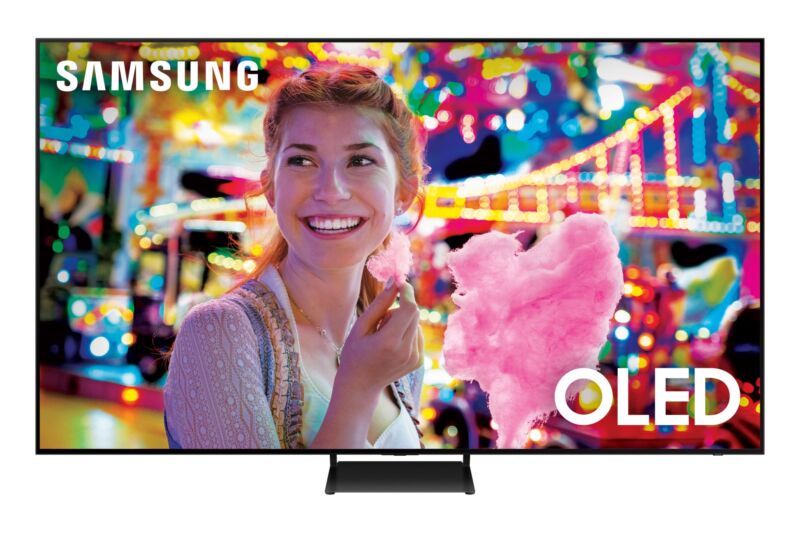
Samsung
Samsung is about to start selling its first TVs with OLED panels from rival LG after months of negotiations. Unfortunately, the way the TVs coming out of this deal are branded and marketed can cause confusion among consumers who want the most bang for their buck.
On Tuesday, Samsung published a blog post revealing a new 83-inch TV that’s part of the company’s existing S90C range of high-end OLEDs. In reality, the set had been leaked weeks earlier, when HDTV Test’s extraordinarily obsessive and detail-oriented TV pundit Vincent Teoh was quick to point out that Samsung doesn’t currently make 83-inch panels themselves – meaning this is the first TV in Samsung’s deal with LG. .
The complicated story behind Samsung’s new OLEDs
The Samsung-LG deal has been rumored in fits and starts for months. While LG made and shipped OLED TVs and panels and talked about the benefits of OLED compared to the good old LED LCDs, Samsung stuck to shipping LCD TVs and introduced new technologies to try and keep the older technology competitive. hold.
Samsung has been in a difficult position recently, however, as Chinese makers of the LCD panels critical to Samsung’s TV range have been charging higher and higher prices. That, along with LG’s successes in shifting public opinion about high-end TVs to OLED, led to Samsung adopting OLED technology in some of its high-end TVs.
Samsung only produces OLED TV panels in 55, 65 and 77-inch sizes, while LG has been making larger ones for some time. Super-large TVs are one of the fastest growing market segments, and many consumers looking to buy one also want to make sure they’re getting the best possible picture quality.
The Samsung chaebol has close ties to the South Korean government, so government officials reportedly arranged meetings between Samsung and LG (which is also a South Korean company) so that LG could supply larger panels to Samsung to keep the giant competitive . After some issues, the two companies came to an agreement in which LG would supply Samsung with 77- and 83-inch panels.
Introducing yet another Samsung TV format into an existing line wouldn’t normally attract much attention here, but there are two reasons why this deserves closer scrutiny.
First, there’s the industry implications of the aforementioned Samsung-LG deal, which certainly seems to seal the deal that high-end TVs will generally be OLEDs for the foreseeable future, pushing LCDs into the lower and mid-range segments (where it honestly belongs at this point). ). Related to that, there’s the side note that Samsung has been publicly critical of both OLED and LG’s specific implementation of it for ages, only to gleefully start selling the exact same thing it criticizes.
Second, there’s the fact that LG’s panels are built with a different technology and sub-pixel arrangement than Samsung’s existing OLED TVs, potentially confusing consumers.
Sub pixel arrangements and consumer confusion
Samsung’s existing 55-, 65-, and 77-inch TVs in the S90C line all use QD-OLED, a relatively new OLED technology that promises better colors at high brightness and (in theory, at least) longer battery life. the panel with less fire-risk. LG’s panels use WRGB, which can provide higher overall brightness in some specific cases, but could otherwise be considered a bit lower.
The new 83-inch S90C uses WRGB, while the other three sizes currently use QD-OLED. To make things even more confusing, LG’s deal with Samsung also included 77-inch panels, which could mean that consumers could experience a panel lottery in the 77-inch format in the future, i.e. they may not know what technology they get. when they buy.
That’s speculation, of course, as only the 83-inch model has been announced so far, and we know that’s WRGB. But it’s something to watch, as Samsung has so far been opaque about what OLED technology it’s using. All of the TVs reviewed here are marketed simply as “OLED.” Samsung doesn’t make separate product lines for these two-panel types, so even if all the 83-inch TVs in the line use WRGB and all the 55-inch TVs use QD-OLED, most consumers won’t know unless they do some digging. on enthusiast sites like Rtings or HDTV Test. They assume they’ll get essentially the same image quality and performance regardless of size, and that’s not necessarily the case.
Samsung 83″ Class S90C OLED 4K Smart TV
Vincent Teoh of HDTV Test noted in a video that there are a few easy ways to check which panel technology is being used when you have the TV in front of you. You can take a zoomed photo of a clear image on the TV and view the sub pixel arrangement. If it has a triangular shape that’s typical of QD-OLEDs, you know it’s, well, QD-OLED. If not, it’s WRGB. You can also shine a bright light on the screen when it is off. If it shifts to gray, it’s QD-OLED. If not, it’s WRGB.
But most people order their TVs sight unseen online at this point, so that won’t help everyone. So if you’re looking for a big OLED TV and you’re considering the world’s most popular brand as you shop, make sure you do some extra research, because Samsung’s marketing spin won’t necessarily tell you everything you need to know. to make the best choice.

